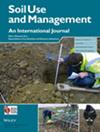Soil fungal communities under slash‐and‐burn system in Mozambique: A metataxonomic approach
IF 3.7
3区 农林科学
Q1 SOIL SCIENCE
引用次数: 0
Abstract
This study provides a metataxonomic analysis of the fungal communities in soils under slash‐and‐burn agroforestry system and offers new insights into the relationships between fungal populations and soil physicochemical features such as pH, the particle size distribution, easily oxidizable organic carbon, total nitrogen, available phosphorus, and the mineralogical composition. Soils from three locations in central Mozambique—Vanduzi, Sussundenga, and Macate—that are subjected to slash‐and‐burn were considered to assess the effects of the forest fallow length (temporal variation) and of the land use (charcoal kiln, crop field, and forest; meaning horizontal variation) on the fungal community. The fungi of the genetic horizons (vertical variation) were also considered. Most of the detected fungi were decomposers, antagonists of plant pathogens, and plant‐growth promoters; they were differently distributed in relation to the soil's physicochemical properties and the soil use. The variations in the fungi distribution among the locations and between the horizons were considerable, while there were few variations between the different land‐use types. The limited differences between land uses indicate the inability of a forest fallow period shorter than 50 years to improve soil fertility and induce changes in the fungal community. The pedological approach used to identify and sample soil horizons allowed us to clearly distinguish the fungal community of the A horizons, those richest in organics and nutrients, and that of the Bo horizons, which have poor fertility.莫桑比克刀耕火种制度下的土壤真菌群落:元分类方法
本研究对刀耕火种农林系统下土壤中的真菌群落进行了元分类分析,并对真菌种群与土壤理化特征(如 pH 值、粒径分布、易氧化有机碳、总氮、可利用磷和矿物成分)之间的关系提出了新的见解。研究人员考虑了莫桑比克中部三个地方的土壤--万杜齐(Vanduzi)、苏森登加(Sussundenga)和马卡特(Macate)--这些土壤都是刀耕火种的土壤,以评估森林休耕期(时间变化)和土地利用(木炭窑、农田和森林,即水平变化)对真菌群落的影响。此外,还考虑了遗传地层的真菌(垂直变化)。检测到的大多数真菌都是分解者、植物病原体的拮抗剂和植物生长促进剂;它们的分布与土壤的理化性质和土壤用途有关。不同地点和不同地层之间的真菌分布差异很大,而不同土地利用类型之间的差异很小。不同土地用途之间的差异有限,这表明森林休耕期短于 50 年并不能提高土壤肥力和引起真菌群落的变化。采用土壤学方法识别和取样土壤层,使我们能够清楚地区分有机物和养分最丰富的 A 层和肥力较差的 Bo 层的真菌群落。
本文章由计算机程序翻译,如有差异,请以英文原文为准。
求助全文
约1分钟内获得全文
求助全文
来源期刊

Soil Use and Management
农林科学-土壤科学
CiteScore
7.70
自引率
13.20%
发文量
78
审稿时长
3 months
期刊介绍:
Soil Use and Management publishes in soil science, earth and environmental science, agricultural science, and engineering fields. The submitted papers should consider the underlying mechanisms governing the natural and anthropogenic processes which affect soil systems, and should inform policy makers and/or practitioners on the sustainable use and management of soil resources. Interdisciplinary studies, e.g. linking soil with climate change, biodiversity, global health, and the UN’s sustainable development goals, with strong novelty, wide implications, and unexpected outcomes are welcomed.
 求助内容:
求助内容: 应助结果提醒方式:
应助结果提醒方式:


